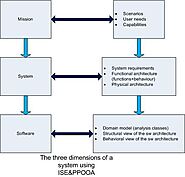-
About
- About Listly
- Community & Support
- Howto
- Chrome Extension
- Bookmarklet
- WordPress Plugin
- Listly Premium
- Privacy
- Terms
- DMCA Copyright
- © 2010-2025 Boomy Labs

 Tim Weilkiens
Tim Weilkiens
Listly by Tim Weilkiens
There is no best MBSE methodology. You have to find out for yourself which methodology suits you best. This list will help you do that. More information about MBSE methodologies can be found at https://mbse-methodologies.org.
If a method is missing from your point of view, add it or write me at tim@mbse4u.com. Likewise, if you know of a better link.
The order of the list is calculated based on the votes.
Let yourself be guided with Arcadia, a comprehensive methodological and tool-supported model-based engineering guidance.

MagicGrid® is a unique, model-based systems engineering experience. It guides you through one of a million possible straightforward ways to develop a system model from A to Z. It is an answer to all the questions you may have, starting from “why” and ending with “how”, which few of today’s available sources of information can answer. Download the BoK and experience it yourself.

SYSMOD is a MBSE toolbox for pragmatic modeling of systems. It is well-suited to be used with SysML. The toolbox provides a set of methods with roles and outputs. Concrete guidances and examples show how to apply the methods with SysML.

The FAS method is a method for the use-case-driven creation of a functional architecture for systems, first published by Jesko G. Lamm and Tim Weilkiens at the TdSE conference in Munich, Germany, in November 2010. The conference paper is the definition and foundation of the FAS method. The method bridges Systems Analysis and System Architecture, facilitating the work in product realization teams. It is expected to improve re-use in development organizations, based on the notion that functional architecture descriptions are valid across multiple generations of technology.

Object-Process Methodology (OPM) is a comprehensive novel approach to systems engineering. Integrating function, structure and behavior in a single, unifying model, OPM significantly extends the syste
Object-Oriented SE Method Working Group

The Harmony aMBSE process is an agile and lean approach to model-based systems engineering. It is detailed in the Agile Systems Engineering book (see Books section) and a very detailed example is available in the Harmony aMBSE Deskbook (see the Papers section).

This website describes ISE&PPOOA MBSE (Model-Based Systems Engineering) methodology that uses SysML notation and is tool independent.
The website describes ISE&PPOOA training itineraries we proposed as well.

STRATA™ is a layered approach to systems engineering and general problem solving. Rather than executing deep dives around specific topics or subsystems, STRATA focuses first on understanding the top-level interactions—between requirements, between the system and its environment, between aspects of the architecture—before moving to greater depth in areas of interest. Executed properly, STRATA is an effective and efficient approach to aligning team understanding of problem and solution, unlocking the collective team intelligence and providing a framework within which detailed decisions are informed by the greater context.
This section gives a very brief and rough overview over the Harmony process. The overview is far from being exact or accurate. The reader is refered to the "System Engineering Best Practices with the Rational Solution for Systems and Software Engineering Deskbook" (Release 4.1) by Hans-Peter Hoffmann for exact and complete information regarding the Harmony process definition.
Requirements development, project management and system design integrated in one tool for model-based systems engineering.

System modeling is continuing to grow in importance as the enabling discipline for digital engineering. Descriptive system models can be used as the “central nervous system” of a system development effort (to federate a constellation of analytical models and other engineering content). Hypermodeling is a methodology focused on maximizing model elegance through the efficient generation of a descriptive system model (with appropriate supporting content). It emphasizes the most simple, direct approach to rigorously capturing relevant information. Hypermodels use a limited set of model elements, relationships, and properties and seek to maximize the amount of information derived from the model. The NeMO hypermodel, an example built by students at the University of Detroit Mercy, provides a comprehensive demonstration of this approach and includes behavioral, structural, and analytic information as well as metrics and requirements. It is hoped that this large example will serve as a focus for discussion and experimentation in the system modeling community. Links to hypermodeling tutorial videos are available for study and comment at the hypermodeling website: http://hypermodeling.systems.
